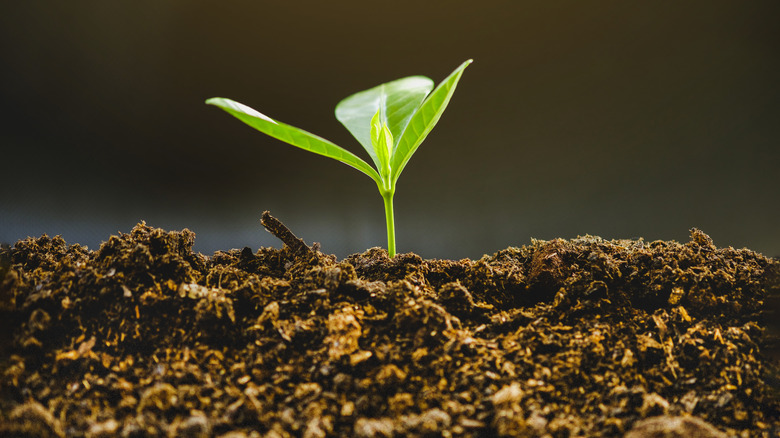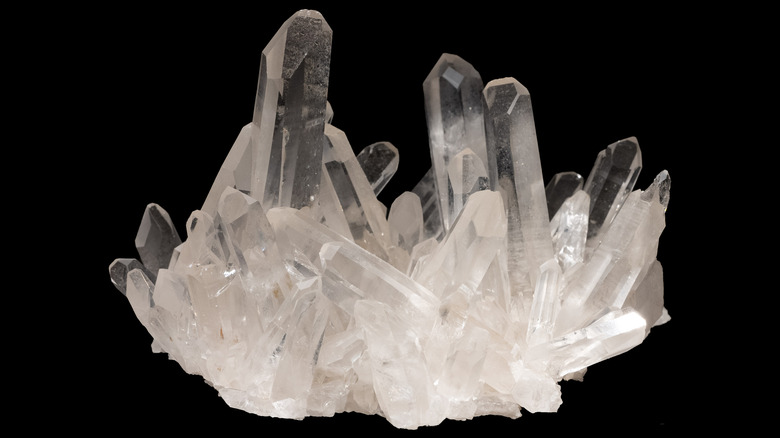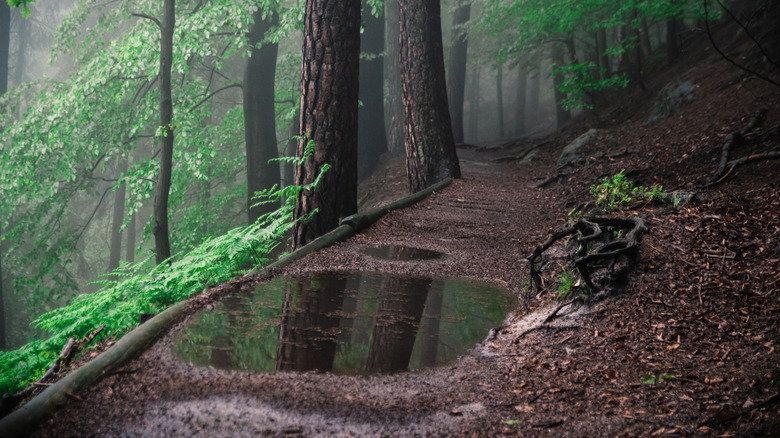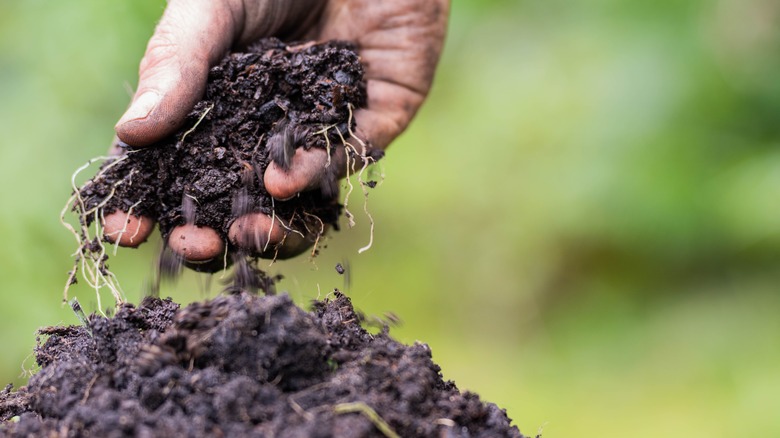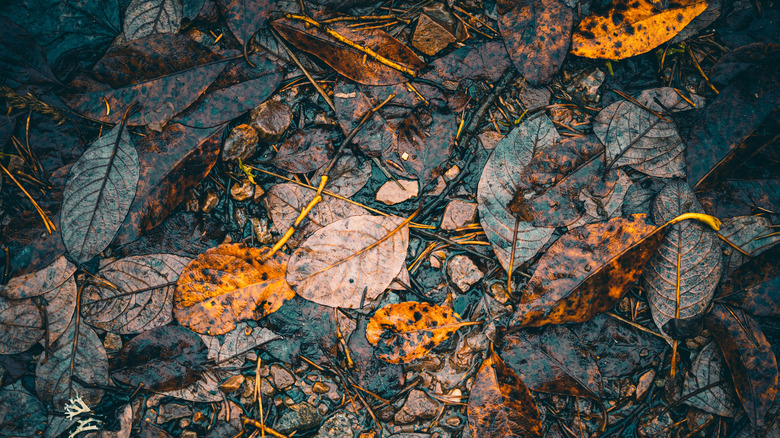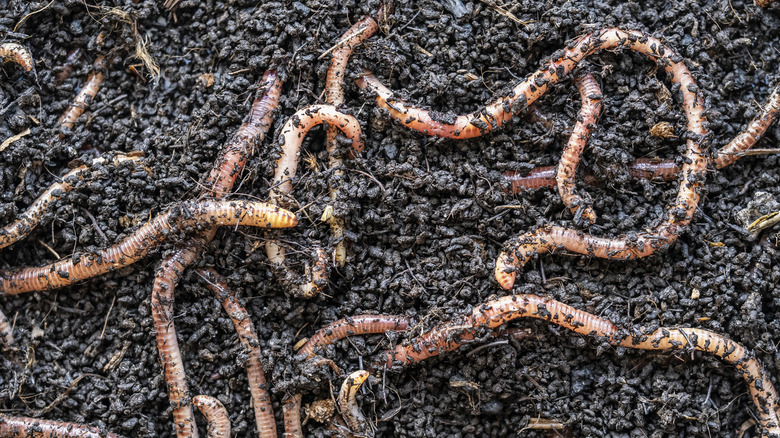Here's What Soil Is Made Of And How It's Formed
Soil is the foundation of life on land. From the soil grow the plants that feed us and fill our atmosphere with oxygen. It stores nutrients that it passes along to us through the food chain. It filters pollutants, making it one of the most crucial soldiers in the battle between nature and anthropogenic climate change. It's so essential to life that, much like the air we breathe, we rarely take the time to notice soil and to consider exactly what it actually is. But understanding what soil is made from and how it is formed is essential to understanding what it takes to make a healthy planet.
Broadly speaking, there are two types of soil: topsoil and subsoil. Topsoil is the uppermost layer of the soil, the part exposed to our eyes. This layer is fairly thin but incredibly rich in nutrients, so it's where you'll find most plant roots, as well as earthworms, bugs, and microorganisms invisible to the human eye. The subsoil is a thick layer between the topsoil and the underlying rock. It is less nutrient-rich than topsoil, and is generally lighter in color and denser, although some plant roots do extend into subsoil.
Topsoil and subsoil are composed of the same basic materials, though not in equal proportions. There are five core ingredients to soil: minerals, water, air, organic materials, and living organisms. It takes thousands of years for all of these components to come together and form the fertile ground that nurtures us.
Minerals
Minerals are the primary component of soil, accounting for roughly 45% of most soils. Due to their central importance, these are also known as parent materials. Most of these minerals originate in sedimentary rock, which makes up over three-quarters of the Earth's crust. Geological activities like temperature changes, precipitation, and wind cause rock to weather and erode, breaking down into the particles that soil is made from. Minerals also provide key nutrients to plants and microorganisms in the soil.
Soil is composed of numerous different minerals, and among the most abundant among them is a group known as feldspars, which are minerals containing calcium, sodium, or potassium. Another abundant mineral in soil is quartz. Yes, surprising though it may seem, a lot of the brown dirt we walk on is the same stuff those beautiful crystals are made of.
The mineral components of soil are divided into three groups according to texture, which in turn is determined by particle size. Large mineral particles, those between 0.05 and 2.00 millimeters, are what we know as sand. Mid-sized particles between 0.05 and 0.002 mm in diameter are known as silt. The finest mineral particles are known as clay. Clay soil clumps to itself and is mainly found in subsoil, which is why soil gets denser the deeper you go.
Water
On average, water makes up about a quarter of all soil, although that can vary considerably depending on climate, as well as the type of soil minerals involved. Sand particles, being relatively large, cannot pack together tightly and leave lots of empty space between for water to flow. This makes sandy soil great for drainage but bad at retaining water. On the other hand, silt and clay display strong water-retaining abilities. Among the many dire consequences of climate change is its effect on soil water retention, with droughts in some regions resulting in even drier soils and excessive rainfall in other regions causing oversaturated soil.
One of water's most important roles in soil has to do with nutrient distribution. The nutrients found in soil — critical elements such as calcium, potassium, iron, and magnesium — are carried to plants via the water that roots absorb. The water in soil plays other crucial roles as well. It helps to regulate heat transfer between the ground and the air, and it is also essential for plants to perform photosynthesis, giving life to the plants and creating the oxygen we all need for survival. Without water, soil would be incapable of supporting life.
Air
Air also makes up about a quarter of all soil, stored in pores between mineral particles. This is where all the organisms living within the soil get the oxygen they need to live. Maintaining airflow within the soil is essential to supporting life, and it's something that farmers are constantly contending with. The practice of soil aeration, in which farmers poke holes in soil to introduce air and water, is an important step in maintaining a healthy crop cycle.
The air component of soil also plays a crucial role in regulating greenhouse gases in the atmosphere. When plants absorb carbon dioxide from the air, they use some of it in the process of photosynthesis, but they also deposit a great deal of carbon into the soil when they inevitably die and decompose. Most things that die on land end up breaking down into the soil, and carbon release is a major component of that process.
The air in soil contains more carbon dioxide than atmospheric air and a lower proportion of oxygen. Soil is the second-largest storage point for carbon dioxide after the oceans, and that makes soil essential in the fight against climate change. However, human developments, particularly our expansive farmlands, have reduced the carbon-capturing power of soil in many areas.
Organic materials
Organic matter is an umbrella term to refer to all the dead stuff in the soil. It can be grouped into two main categories, called detritus and humus. Detritus is also known as active soil matter, and is composed of dead plants and animals that are actively decomposing. Fallen leaves, dead flowers, and deceased animals all contribute to the formation of detritus, but that's only the first step in forming the organic materials in our soil.
The other kind of organic material in soil is humus. Humus refers to plant and animal materials that have been fully decomposed. This happens when living organisms in the soil, such as earthworms, insects, and fungi, consume detritus and return it to the soil through their waste excretions. By the time detritus has been fully converted to humus, it is no longer capable of providing food for live organisms, and is thus referred to as passive soil matter. Despite the fact that animals can no longer feed on it, humus is crucial to soil health, as it helps soil retain water.
The rate at which dead plants and animals decompose into detritus and are ultimately converted into humus can vary considerably depending on soil conditions, particularly which organisms are present in the soil to consume organic matter. In some places, this process occurs very slowly over decades, and so is known as slow soil matter.
Living organisms
Along with organic materials, living organisms compose about five percent of soil overall. Although it's the smallest component of soil, it plays a vital role. We have a tendency to overlook all the things that live in soil, mainly because a great deal of them are too small for us to see. However, soil is actually the most biodiverse habitat on the planet, being home to over half of the species on Earth. Research published in the Proceedings of the National Academy of Sciences estimates that 85% of plant life and 90% of fungi are found in the soil. On top of that, around half of all bacterial species live in the soil.
There aren't many mammals living in the soil, although moles, gophers, and foxes are notable residents. Earthworms and arthropods like mites, roly-polys, millipedes, and spiders frequently cross paths with humans. However, most soil species exist out of sight, like nematodes, microscopic worms that feed on decomposing organic material. Nematodes, earthworms, bugs, and bacteria all play a critical role in converting detritus into humus, maintaining soil fertility. A single acre of soil can contain enough bacteria to equal the weight of an adult cow: that's over a thousand pounds of life teeming under your feet.
